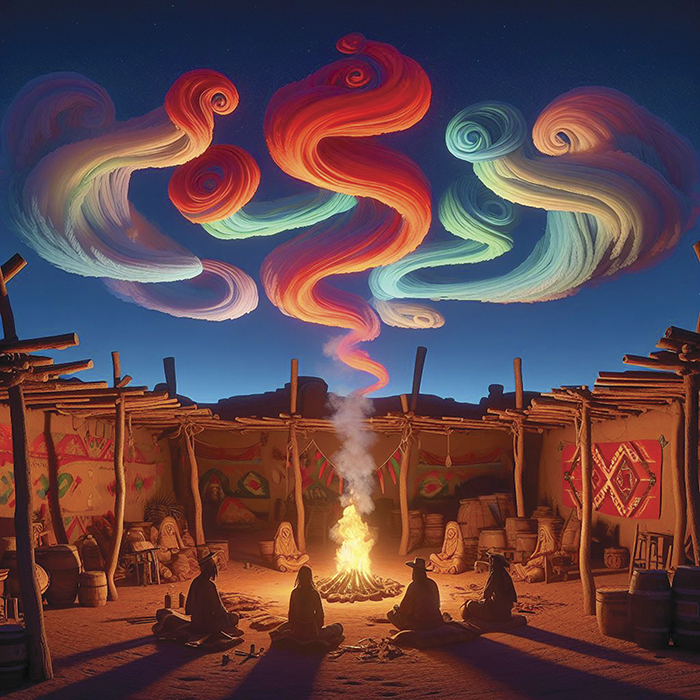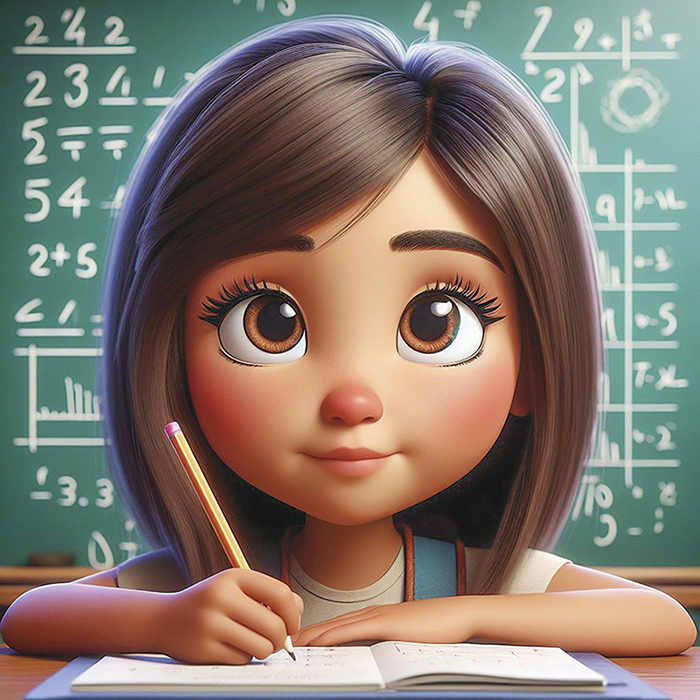
‘The Navajo AI Flower’: AI-generated Diné girl peeks into AI knowledge from non-Navajo creators

Courtesy | Azai Project
Aiyana, the young girl sitting beside a friend, listens to a Diné elder in the “Aiyana, The Navajo Flower” series.
WINDOW ROCK – A trip to the Grand Canyon and decades-old memories of Dinétah and research on Diné inspired an artificial intelligence-generated series created by a non-Indigenous duo.
Based in London, the two creators of “Aiyana, The Navajo AI Flower,” Christopher Richardson and Ava Tien, rely heavily on their memories and research of Navajo people to make artificial intelligence, or AI, knowledge relatable to Diné.

Courtesy | Azai Project
In the series “Aiyana, The Navajo AI Flower,” artificial intelligence generates what the Navajo Nation and culture look like with vibrant colors and the community gathered together.
As a young child in the 1960s, Richardson traveled to and around Dinétah with his family in their Volkswagen van during a three-month summer break.
“I remember a lot of the area. It was beautiful, the rocks and everything,” said Richardson.
In the 10 different minute-long episodes of “Aiyana, The Navajo AI Flower,” Aiyana is seen in AI-generated locations of Dinétah depicting the different rock formations that Richardson saw.
Tien visited the Grand Canyon, home to multiple tribes, including Diné, last summer.
Tien had seen the many rock layers in the vast canyon and was able to understand better the environment in which Navajos live.
Researching Diné
Aside from the memories, Richardson and Tien research Navajo people and language to portray Diné culture and Dine’é as best they can as outsiders.
Traditionally, Diné society is matrilineal. Both creators understood and ultimately landed on a young girl to help convey AI knowledge.
Richardson and Tien believe having a young Navajo girl as the main character also encourages young girls to embrace science and technology and that the fields aren’t just for boys.
“We thought if we got youth interested in AI, then maybe they can take it up as a career,” said Richardson.
The two creators also had to figure out how to best share AI knowledge with youth and all Diné in the Navajo Nation.
Richardson ensured the language used in the videos was straight to the point and not loaded with scientific jargon so the audience stays engaged.
Along with piquing interest in the series, the AI-generated pictures create a Disney-like cartoon.
Aiyana has big doe eyes, straight dark brown hair, rosy cheeks, and light brown skin.
The series starts with Aiyana’s interest in science and being smart, but she pushes past the ridicule to learn what AI is and how it can benefit her community.
Looking to másáni, speaking Diné Bizaad
Aiyana looks to bimásáni, her grandmother in the series to discover what the needs are among Diné.
Through research, Richardson and Tien focus on environmental elements of the Navajoland, water, fire, and air, to show that AI can help in those areas.

Courtesy | Azai Project
In the “Aiyana, The Navajo AI Flower” series, Aiyana, a math genius, is a young Diné girl with Disney-like brown eyes and brown hair who enjoys math and is interested in learning about artificial intelligence to help her community.
Richardson and Tien believe many people have a misconception of AI just being in photos and over social media chats. Still, it can also benefit other aspects of life, such as agriculture.
The ongoing series will soon present examples of AI utilization in Diné lifestyles in the Nation.
“It’s like a tree. You’ve got to grow,” said Richardson about AI knowledge.
Lejend Yazzie, 24, is a Diné filmmaker from Crystal, New Mexico, who has been a part of the film and production industry for four years in countless projects with Navajo and non-Navajo teams.
Yazzie has not seen the series, but as a film director with experience in the industry knows proper Indigenous representation is a must in all forms of media like the AI animated series.
“What I’ve encountered by non-Native people specifically,” said Yazzie, “is they kind of treat me like the keeper of all Navajo language and culture and kind of think of me as a cultural liaison when that’s not my job.”
While Yazzie is Navajo in the film and production industry, she is not a cultural advisor for the proper representation of Indigenous people in movies and media.
Yazzie remembers being a part of a film crew with a Navajo director, but the crew didn’t speak Navajo, and parts of the film were meant to be in Navajo.
The director sought a Navajo language speaker so that the film would properly represent Diné.
From personal experience of non-Navajos making fun of Indigenous lifestyles and culture, Yazzie knows there’s harm in the lack of Indigenous representation when films or media are created about Indigenous people.
“There’s a lot of Indigenous people, specifically Navajos who want to tell stories,” Yazzie said, “who are creative and are artists but aren’t afforded the opportunity because of who they are.”
Cultural sensitivity
Yazzie believes if non-Navajos want to tell a story about Navajo people, they need a cultural consultant who is of the community and knows the culture well.
“Personally, I don’t believe it’s ethical or right to have non-Navajo people write or tell Navajo stories just based on research. If you truly feel called to do that, then you need to have a cultural consultant,” said Yazzie.
Richardson and Tien understand Yazzie’s standpoint and agree with her, but their goal is to teach about AI and not dive too much into the cultural aspect.
“I picked some well-known topics of undisputed things about the Navajo Nation, so I don’t try to go into teaching people about Navajo culture and things like that,” said Richardson.
‘Flavor’ in AI
Richardson’s specialty is knowledge of AI and using an AI-generated Navajo girl and Navajo issues that AI can help add “flavor” to teaching about AI.
Richardson tried to incorporate Diné Bizaad in the early series of videos, but after reading comments about not pronouncing words correctly, he stopped. He is continuing to learn Diné Bizaad through Duolingo.
Richardson not only wants youth to learn about AI, but he wants outside AI organizations to see that there’s a rural community that could benefit from their services.
Both creators are open and happy to collaborate with Diné to better the authenticity of the series.








 Highway 264,
Highway 264, I-40, WB @ Winslow
I-40, WB @ Winslow